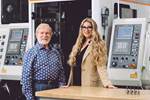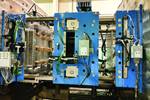Cube Mold Technology Advancing Injection Molding
Injection mold design features a central rotating cube that can split and counter-rotate, with additional gear elements on the exterior.

Cube Mold technology enhances the production of plastic products by offering technical and economic benefits. This injection mold features a central rotating cube that can split and counter-rotate, with additional gear elements on the exterior. Developed by Rainer Armbruster of Foboha, part of Barnes Molding Solutions, the Cube Mold has evolved since its creation in the mid-1990s.
Cube Molds double the number of cavities compared to traditional two-component turntable molds, with minimal increase in footprint. This design increases production and reduces cycle time by up to 40%, particularly when integrated with a removal handling system. Unlike conventional molds, which require handling systems to move between mold halves, Cube Molds enable removal on the outside.
For smaller-volume productions, the Compactcube system enables flexible machine configurations with minimal modifications. Designed for clamping forces between 1,000 to 3,000 kN, the Compactcube can either double the number of cavities or enable the use of smaller machines, reducing space requirements by about 25%. This is useful in cleanroom environments for medical manufacturing.
The Reversecube offers thermal separation for processing materials with different temperature requirements, enabling the assembly of complex components within the mold. The CITI (Cube with Integrated Turning Inserts) variant includes additional rotating elements on the cube's exterior, enabling the production of 3K parts. This technology has been applied in the beverage industry to produce multi-material components in a compact and efficient manner.
As Cube Mold technology approaches 30 years, its design continues supporting ongoing injection molding developments.
Related Content
-
How to Eliminate Chatter
Here are techniques commonly used to combat chatter and guidelines to establish a foundation for optimizing the moldmaking process.
-
The Ins and Outs of Hot Runner Temperature Control
A training checklist that explains the why and how of proper hot runner temperature control and system management.
-
Laser Welding Versus Micro Welding
The latest battle in finely detailed restoration/repair of mold materials.















